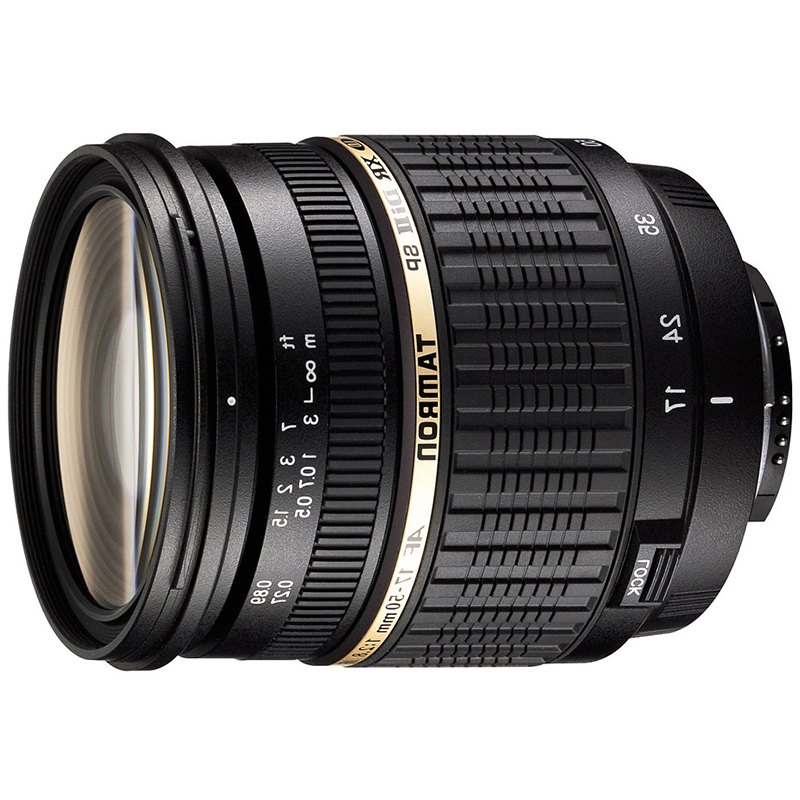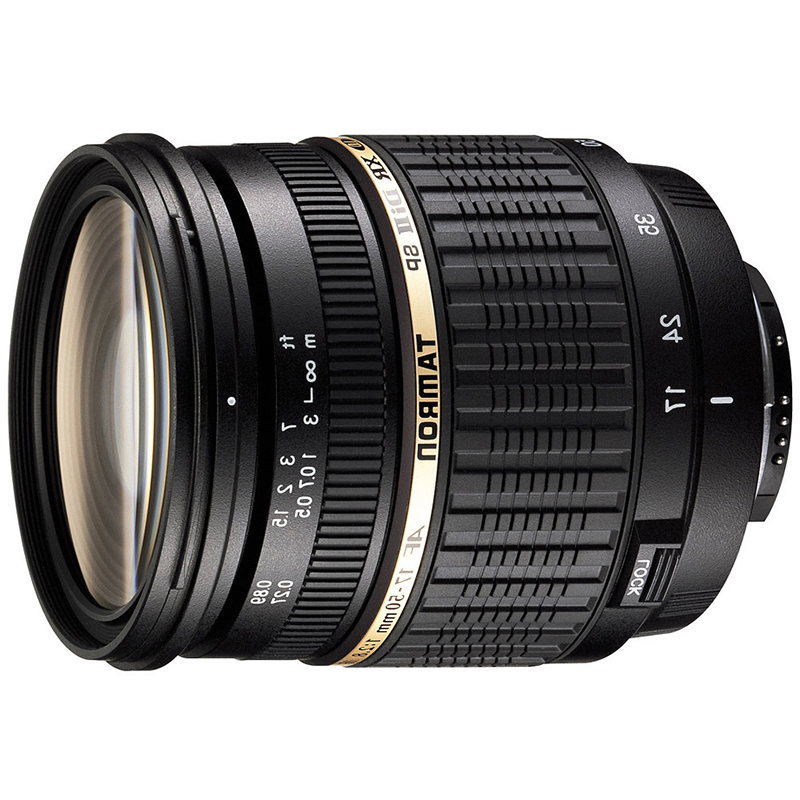
Tamron SP AF 17-50mm F2.8 XR DI II VC LD Aspherical (IF) Lens
- F/2.8 Maximum and F/32 Minimum Aperture
- ø72 Filter Diameter
- Wide-to-moderate-telephoto zoom characteristics
- Internal focusing (IF) system
- XR (Extra Refractive Index) and LD (Low Dispersion) glass
- Tri-axial VC (Vibration Compensation) image stabilization adding to image sharpness
- 24 Months Warranty with Maxwells International Australia
To the discerning photographer that aims for extraordinary photographic performance, the Tamron SP 17-50MM F/2.8 Di II VC is a choice lens to buy. Within its scope is the popular wide-to-moderate telephoto zoom that has 17-50mm focal length range (equivalent to 26-78mm in the full-frame 35mm format*), making it extremely apt for any distance. Its F/2.8 maximum and F/32 minimum aperture, quick and steady, and ø72 filter diameter allow better focus and performance in lowlight conditions. Its tri-axial VC (Vibration Compensation) image stabilization adds to the already high-end image sharpness. With the XR (Extra Refractive Index) glass that can bend light rays at steeper angles, low dispersion (LD) glass that help reduce chromatic aberration, hybrid aspherical lens elements, and internal focusing (IF) system that enhances focusing limits, this lens brings forth the ultimate among the best pictures that can be captured. It is compatible only with APS-C DSLR Cameras.
Product Features in Detail
Special Glass for Better Performance and More Compact Lens Designs
XR (Extra Refractive Index) glass can bend light rays at steeper angles, thereby decreasing the physical length of the lens while enhancing imaging performance by minimizing optical aberrations. This has allowed Tamron to develop a line of shorter, smaller-diameter, lighter lenses without sacrificing lens speed, and actually upgrading image quality compared to older designs. XR glass is costlier than conventional glass but it yields enhanced optical power distribution, making possible many of the outstanding and innovative lens designs that bear the XR designation. XR glass, with its superior light-bending power, makes it possible to design a short-barrel lens with the same light-gathering ability (aperture value) as a long-barrel lens—even with a smaller lens diameter. By using this principle Tamron has been able to shorten the length of the entire optical system and produce lighter, more compact lenses of the same speed, and also to provide greater zoom ranges in lenses that are much more convenient to carry and hand-hold.
Low Dispersion (LD) Glass for Greater Lens Sharpness
Low dispersion (LD) glass elements in a lens help reduce chromatic aberration; the tendency of light of different colors to come to different points of focus at the image plane. Chromatic aberration reduces the sharpness of an image, but glass with an extremely lowdispersion index, has less of a tendency to separate (defract) a ray of light into a rainbow of colors. This characteristic allows the lens designer to effectively compensate for chromatic aberration at the center of the field (on axis), a particular problem at long focal lengths (the telephoto end of the zoom range), and for lateral chromatic aberration (towards the edges of the field) that often occurs at short focal lengths (the wide-angle end of the zoom range.)
Hybrid Aspherical Elements Provide the Ultimate in Image Quality and Compactness
Tamron uses several hybrid aspherical lens elements in many lenses bearing the Aspherical designation. These innovative optics allow us to achieve the ultimate in image quality, and at the same time produce lenses that offer remarkable zoom ranges in extraordinarily compact packages. By perfecting theses cutting-edge advances for series production, Tamron has advanced the state of optical design, and virtually eliminated spherical aberration and image distortion from the high-power-zoom series.Through the effective application of Hybrid Aspherical Technology, one lens elemen tcan take the place of multiple elements without compromising performance. This is what allows us to produce remarkably compact long-range lenses that deliver a uniformly high level of image quality at all focal lengths and apertures.
Internal Focusing (IF) System
Internal focusing (IF) provides numerous practical benefits to photographers including a non-rotating front filter ring that facilitates the positioning of polarizing and graduated filters, and more predictable handling because the lens length does not change during focusing. Even more important, Tamron’s Internal Focusing (IF) system provides a much closer minimum focusing distance (MFD) throughout its entire focusing range. In addition, IF improves optical performance by minimizing illumination loss at the corners of the image field, and helps to suppress other aberrations that become more troublesome at different focusing positions.
Cleaner, crisper images without flare or ghosting
The latest BBAR (Broad-Band Anti-Reflection) multi-layer coatings reduce reflection from the lens, ensuring excellent performance in all photographic conditions. These coatings enhance light transmission in both short and long wavelengths. Internal coatings have also been applied to all the cemented surfaces of lens elements, providing sharpness, optimum colour reproduction and excellent colour balance.
Compact size with a filter thread of Ø72mm, while delivering both a large f/2.8 diameter and VC
The addition of an image stabiliser tends to increase the size of a lens. As this lens is a large-diameter f/2.8 zoom, the optical image stabilisation system is also relatively large compared with other VC models. However, through improvements to optical, mechanical and VC designs, the filter thread is a compact 72mm.
Zoom-lock mechanism
Useful when carrying the lens/camera over the shoulder. Another original Tamron mechanical engineering concept is the zoom-lock mechanism, which prevents the weight of the lens barrel from extending the lens when carried on the camera pointing downward. This eliminates the danger of accidentally knocking the lens while walking around and enhances responsiveness in the field. Simply zoom the lens out to its widest focal length and use the sliding zoom-lock switch to lock the barrel in place.
Sharpens edges by reducing 'colour fringing'
Chromatic aberration occurs when a lens element refracts different wavelengths of a ray of light – its rainbow colours – at very slightly different angles. This results in the 'colour fringing' that reduces the sharpness of an image. LD elements are made from special glass materials with extremely low dispersion indices (i.e. the refraction of a ray of light into rainbow colours is extremely narrow). Thus they effectively compensate for chromatic aberration at the centre of the field (on axis), a particular problem at long focal lengths (the telephoto end of the zoom range), and for lateral chromatic aberration (toward the edges of the field) that often occurs at short (wideangle) focal lengths.
Focusing elements inside the optical design make for better handling
In many lenses, the front elements move back and forth to alter the focus distance. With an internal focusing (IF) mechanism, the focusing elements are inside the optical design. Because the front lens elements remain static, the lens’ actual length does not change.
More compact lenses with superior image quality
XR (Extra Refractive Index) glass can bend light rays at steeper angles, thereby decreasing the physical length of the lens while enhancing imaging performance by minimising optical aberrations. With its superior light-bending power, XR glass makes it possible to design a short-barrel lens with the same light-gathering ability (aperture value) as a long-barrel lens – even with a smaller lens diameter. By using this principle Tamron has been able to shorten the length of the entire optical system and produce lighter, more compact lenses of the same speed, and also to provide greater zoom ranges in lenses that are much more convenient to carry and hand-hold.
| Model | B005 |
| Lens Construction (Groups/Elements) | 14/19 |
| Angle of View | 78°45'-31°11' (APS-C size equivalent) |
| Diaphragm Blade Number | 7 |
| Minimum Aperture | F/32 |
| Minimum Focus Distance | 11.4in.(0.29m) |
| Macro Magnification Ratio | 01:04.8 |
| Filter Diameter | ø72 |
| Weight | 570g (20.15oz) |
| Diameter x Length | ø3.13 x 3.7in. |
| (ø79.6 x 94.5mm) | |
| Accessory | Flower-shaped lens hood |
| Mount | Canon, Nikon with Built-In Motor |
This product comes with 2 Years Australian Warranty with Tamron.
Our products are sourced from authorised Australian suppliers and therefore come with genuine Australian warranty.
Camera Warehouse does not participate in 'Grey Market' or 'Parallel Import' activities.
Tamron SP 17-50MM F/2.8 Di II VC
Flower-shaped lens hood
24 months warranty with Maxwells International Australia















